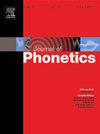Transitory and sustained Cf0 effects: Evidence from Swiss German
IF 2.4
1区 文学
0 LANGUAGE & LINGUISTICS
引用次数: 0
Abstract
It is generally agreed that f0 following phonologically voiceless plosives is higher than after voiced plosives. Such consonant f0 (Cf0) effects have been reported in many languages. However, the phonetic basis of the ‘voiceless’ – ‘voiced’ distinction may differ between languages; for example, in English the distinction involves long-lag VOT in ‘voiceless’ plosives and short-lag VOT or prevoicing in ‘voiced’ plosives, while in Dutch the ‘voiceless’ plosives have short-lag VOT and the ‘voiced’ plosives are generally prevoiced. This study focuses on Swiss German, where neither long-lag VOT nor voicing is present: the primary difference between lenis (‘voiced’) and fortis (‘voiceless’) plosives lies in closure duration. Replicating Ladd and Schmid [Journal of Phonetics (2018), 71, 229–248], we show that both lenis and fortis plosives exhibit higher initial f0 followed by a brief fall, typical of ‘voiceless’ plosives in many languages. Using newer statistical methods (Generalised Additive Mixed Models), we also show that, during the latter part of the vowel beyond the initial f0 drop, overall f0 level is significantly higher after ‘fortis’ than after ‘lenis’ plosives. This suggests that two distinct but interacting Cf0 effects are involved. We discuss the relevance of this finding for future experimental work on Cf0.
短暂和持续的Cf0效应:来自瑞士德语的证据
人们普遍认为,在音系上,后面的不发音元音比后面的浊音元音要高。这种辅音f0 (Cf0)效应在许多语言中都有报道。然而,“不发声”和“发声”区分的语音基础可能因语言而异;例如,在英语中,这种区别涉及到“不发声”爆破语中的长滞后元音和“发声”爆破语中的短滞后元音或前置元音,而在荷兰语中,“不发声”爆破语有短滞后元音,而“发声”爆破语通常是前置元音。这项研究的重点是瑞士德语,那里既没有长滞后的VOT,也没有发声:lenis(“发声”)和fortis(“不发声”)爆破语的主要区别在于关闭持续时间。复制Ladd和Schmid [Journal of Phonetics(2018), 71, 229-248],我们发现lenis和fortis爆破音都表现出更高的初始f0,然后是短暂的下降,这是许多语言中典型的“无音”爆破音。使用较新的统计方法(广义加性混合模型),我们还表明,在元音的后半部分,在初始的f0下降之后,“fortis”之后的整体f0水平明显高于“lenis”之后的爆破。这表明涉及两种不同但相互作用的Cf0效应。我们讨论了这一发现对未来Cf0实验工作的相关性。
本文章由计算机程序翻译,如有差异,请以英文原文为准。
求助全文
约1分钟内获得全文
求助全文
来源期刊

Journal of Phonetics
Multiple-
CiteScore
3.50
自引率
26.30%
发文量
49
期刊介绍:
The Journal of Phonetics publishes papers of an experimental or theoretical nature that deal with phonetic aspects of language and linguistic communication processes. Papers dealing with technological and/or pathological topics, or papers of an interdisciplinary nature are also suitable, provided that linguistic-phonetic principles underlie the work reported. Regular articles, review articles, and letters to the editor are published. Themed issues are also published, devoted entirely to a specific subject of interest within the field of phonetics.
 求助内容:
求助内容: 应助结果提醒方式:
应助结果提醒方式:


